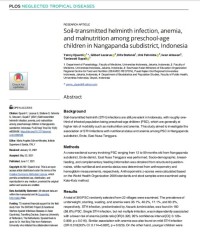Soil-transmitted helminth infection, anemia, and malnutrition among preschool-age children in Nangapanda subdistrict, Indonesia

Author
Yenny Djuardi - Personal NameGilbert Lazarus - Personal Name
Difa Stefanie - Personal Name
Umi Fahmida - Personal Name
Iwan Ariawan - Personal Name
Taniawati Supali - Personal Name
Abstract
Background: Soil-transmitted helminth (STH) infections are still prevalent in Indonesia, with roughly one-third of infected population being preschool-age children (PSC), which are generally at higher risk of morbidity such as malnutrition and anemia. This study aimed to investigate the association of STH infections with nutritional status and anemia among PSC in Nangapanda subdistrict, Ende, East Nusa Tenggara.
Methods: A cross-sectional survey involving PSC ranging from 12 to 59 months old from Nangapanda subdistrict, Ende district, East Nusa Tenggara was performed. Socio-demographic, breastfeeding, and complementary feeding information was obtained from structured questionnaires, while nutritional and anemia status was determined from anthropometry and hemoglobin measurements, respectively. Anthropometric z-scores were calculated based on the World Health Organization 2006 standards and stool samples were examined using Kato-Katz method.
Results: A total of 393 PSC randomly selected from 22 villages were examined. The prevalence of underweight, stunting, wasting, and anemia were 33.1%, 40.2%, 17.1%, and 60.3%, respectively. STH infection, predominated by Ascaris lumbricoides, was found in 160 (58.8%) PSC. Single STH infection, but not multiple infection, was independently associated with a lower risk of anemia (odds ratio [OR] 0.320, 95% confidence interval [CI]: 0.126-0.809, p = 0.016). Similar association with anemia was also found on mild STH infection (OR 0.318 [95% CI: 0.114-0.887], p = 0.029). On the other hand, younger children were found to have a higher risk of anemia and stunting. None of the examined variables were independently associated with underweight and wasting.
Conclusion: STH infection as well as anemia and malnutrition were prevalent in this region. However in this study, current STH infections seemed to have minimal negative impact on children's nutritional status.
Detail Information
| Series Title | : | - |
| Call Number | : | - |
| Publisher | : | : PLOS Neglected Tropical Diseases., 2021 |
| Collation | : | PLOS Neglected Tropical Diseases June 17, 2021, (1-16) |
| Language | : | English |
| ISBN/ISSN | : | - |
| Classification | : | NONE |
 Computer Science, Information & General Works
Computer Science, Information & General Works  Philosophy & Psychology
Philosophy & Psychology  Religion
Religion  Social Sciences
Social Sciences  Language
Language  Pure Science
Pure Science  Applied Sciences
Applied Sciences  Art & Recreation
Art & Recreation  Literature
Literature  History & Geography
History & Geography